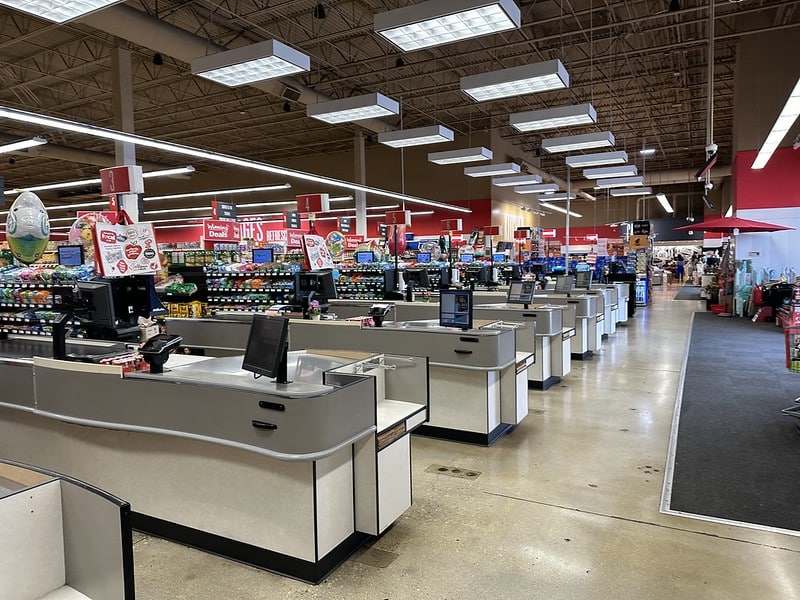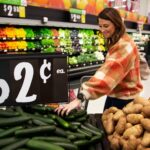
How much shopping around do you do to save money on groceries? Some people find deal-hunting to be a necessity, while others enjoy the thrill of the hunt. Either way, many of us somehow find ourselves frequently shopping somewhere we’d rather not – but we do it anyway.
That’s one of the many insights in a new annual report by FMI – The Food Industry Association. Its “U.S. Grocery Shopper Trends: Finding Value” provides a deep dive into our grocery shopping habits, asking where we get our groceries, how we feel about inflation, and whether we actually like grocery shopping.
Turns out we do like grocery shopping. Just not at that one place where we shop anyway.
When choosing a store, quality and selection are the most important attributes, cited by about three-quarters of shoppers. Low prices are right behind, cited by 71%. Sale prices are further down the list, but still make a noteworthy showing at 62%.
All of those attributes combined add up to “value,” and that’s what the report finds we’re all really looking for. Not just low prices, not just good quality, but the best groceries at the best price.
And since no one store can be all things to all people, we’re willing to shop around for the different types of value that different stores offer. Just not quite as much as we used to.
“Following many years when grocery shoppers visited more and more stores on a regular basis, they have simplified their store mix this year,” the report found. For nearly a decade, the number of stores we regularly visit has been steadily increasing – reaching an average of more than five last year – but that number dipped to 4.9 this year. That’s because, while “older generations prefer to shop across several stores to discover deals or good prices,” younger shoppers, particularly millennials, “favor one-stop value shopping” and have drastically reduced the number of stores they visit.
But shoppers across all generations are willing to make some compromises if necessary. “Many shoppers have at least one store in their rotation they see as offering lower quality or unpleasant shopping experiences but where they shop anyway,” the report found. A store may have terrible customer service, but great prices. It may be messy and disorganized, but has exactly the products you’re looking for. Or it has high prices but great quality.
It’s all about being a “smart shopper,” the report notes. Shoppers take pride in “doing the work of finding good value and providing for themselves and their household” – even if it means having to make compromises or sacrifices, like shopping somewhere you’d rather not.
But some savings strategies are easier – and more popular – than others. Like using coupons. Nearly half of the grocery shoppers surveyed said they take advantage of loyalty program discounts or use digital coupons when grocery shopping. About a third use paper coupons, but that’s down from nearly half who said so the first time FMI asked back in 2016, reflecting both the increasing popularity of digital coupons and the lesser availability of paper coupons.
Shoppers believe they get the best value at club stores, discount grocers and big-box stores, yet they still shop for groceries most often at traditional supermarkets. When ranked by attributes, supermarkets score best among all store formats when it comes to having items on sale and the ability to use coupons and loyalty rewards.
No stores are rated particularly well when it comes to helping shoppers manage inflation, but more shoppers are simply resigned to that. 69% of shoppers said they were very or somewhat concerned about inflation, which is still high, but at its lowest level since FMI began asking that question two years ago. Like it or not, “grocery shoppers understand that these higher prices are now part of their budgets,” the report concludes.
Overall, shoppers may dislike inflation but they still seem to actually like grocery shopping. Shopper sentiment is at its highest level since before Covid. Shoppers “like shopping for food, few consider it a chore, and they tend to have strong, positive relationships with the stores they rely on for groceries,” FMI found. So grocery shopping is not quite a labor of love, but more of a “labor of like.”
And considering the pain of rising grocery prices and the challenge of finding good coupons and deals, the fact that we still seem to enjoy grocery shopping is no small thing. Just as long as you don’t mind visiting that one store you’d rather not – because grocery shopping can be fun at times, but no one ever said saving money was easy.
Image source: Phillip Pessar










